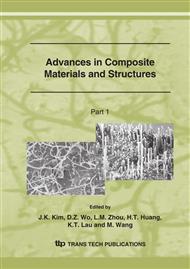p.321
p.325
p.329
p.333
p.337
p.341
p.345
p.349
p.353
Effect of Fiber Content and Fiber Orientation on the Tensile Strength in Glass Mat Reinforced Thermoplastic Sheet
Abstract:
The study for strength calculation of one way fiber-reinforced composites and the study measuring precisely fiber orientation distribution were presented. Need the systematic study for the DB that can predict mechanical properties of composite material and fiber orientation distribution by the fiber content ratio was not constructed. Therefore, this study investigated what affect the fiber content ratio and fiber orientation distribution have on the strength of composite sheet after making Glass Mat Reinforced Thermoplastic Sheet by changing fiber orientation distribution with the fiber content ratio. The result of this study will become a guide to design data of the most suitable parts design or fiber reinforced polymeric composite sheet that uses the Glass Mat Reinforced Thermoplastic Sheet in industry part, because it was conducted in terms of developing products. It studied the effect the fiber orientation distribution has on tensile strength of Glass Mat Reinforced Thermoplastic Sheet and achieved this result below. The increasing range of the value of Glass Mat Reinforced Thermoplastic Sheet’s tensile strength in the fiber orientation direction is getting wider as the fiber content increases.
Info:
Periodical:
Pages:
337-340
Citation:
Online since:
March 2007
Authors:
Price:
Сopyright:
© 2007 Trans Tech Publications Ltd. All Rights Reserved
Share:
Citation:


